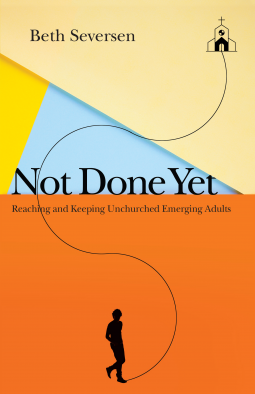
Not Done Yet
Reaching and Keeping Unchurched Emerging Adults
by Beth Seversen
This title was previously available on NetGalley and is now archived.
Send NetGalley books directly to your Kindle or Kindle app
1
To read on a Kindle or Kindle app, please add kindle@netgalley.com as an approved email address to receive files in your Amazon account. Click here for step-by-step instructions.
2
Also find your Kindle email address within your Amazon account, and enter it here.
Pub Date Jul 28 2020 | Archive Date Aug 27 2020
InterVarsity Press | IVP
Talking about this book? Use #NotDoneYet #NetGalley. More hashtag tips!
Description
Nones claim no religion. Dones have become disillusioned and left the church. Research shows many young adults are landing in one of these camps. But that's not the end of the story. Many emerging adults, ages eighteen to thirty-three, are tossing aside the none and done labels and are instead embracing a transformative Christian faith.
Based on her extensive research, scholar-practitioner Beth Seversen outlines a model for how to engage and retain millennials and Generation Z in the life of the local church. Emerging adults are likely to experience spiritual transformation in churches that welcome them into community, provide meaningful opportunities to make a difference, and invest in their development.
Whether you're a senior pastor or a youth minister, a parent or an educator, Not Done Yet will open your eyes to the generational barriers to vibrant faith while equipping you with insights to make your outreach to emerging adults more authentic and impactful.
Advance Praise
"Not Done Yet is a gift to the church. The antithesis of formulas, gimmicks, program-heavy strategies, and other unnatural approaches, this book presents an evangelism that is based on friendship, real church, and changing culture. One senses in these pages a gifted evangelist who is sharing her secrets of bearing witness to the beauty and power of the gospel."
-Al Tizon, affiliate associate professor of missional and global leadership at North Park University, executive minister of Serve Globally, Evangelical Covenant Church
"If your ministry is interested in reaching young adults, Not Done Yet is a strong primer. The five practices—initiate, invite, include, involve, and invest—are not only helpful but something that's congruent with the ways that our most thriving communities tend to operate. These rhythms, if practiced, would be transformative, not only for your faith community but also for the spiritual lives of young adults around you."
-James Choung, vice president for strategy and innovation with InterVarsity Christian Fellowship/USA, author of True Story and Longing for Revival
"Not Done Yet has clearly captured the calling on the church in North America to reach emerging adults in the name of Jesus Christ. Dr. Beth Seversen provides an encouraging voice of challenge and presents a pathway for the church to regain trust with millennials and Gen-Z. The cultural and generational barriers in the church today mandate that we must grow in our understanding and investment for this younger generation. Not Done Yet is a must-read for every leader in your church and community."
-Tim Ciccone, director of youth and young adult ministry for the Evangelical Covenant Church
"Beth Seversen has done her homework. I like her interviews of secular people attending the Burning Man festival. She also highlights various fruitful 'bright spot' churches who are doing a great job reaching today's teens and twentysomethings. Enjoy!"
-Doug Schaupp, national director of evangelism, InterVarsity Christian Fellowship/USA
Available Editions
| EDITION | Other Format |
| ISBN | 9780830841578 |
| PRICE | $22.99 (USD) |
| PAGES | 250 |
Average rating from 3 members
Featured Reviews
Christians, including church leaders, unfortunately engage in a whole lot of victim blaming. They harshly blame confused, doubting, and hurting Christians, calling them “lost,” “heretics,” or simply “wayward sinners.” However, they are not wayward and bitter, prodigal sons or daughters who chose to take all the beautiful things you learned, along with your rich inheritance of the Christian faith, only to squander it in some big debauched and satanic soirée. They are hurting, misunderstood, and are looking for those who will listen and love them. Beth's "Not Done Yet" is an an incredible, thought-provoking, and practical guide for church leaders to be missional-minded when it comes to the unchurched and dechurched (and so the unchurched who become churched don't become the dechurched). Excellent job!!
 Conrade Y, Reviewer
Conrade Y, Reviewer
Every generation comes with their own sets of challenges. Put together multiple generations and the challenges are multiplied. As the Boomer generation ages, the Millenials and the Gen Zs are starting to take center-stage in many parts of society. The same applies to churches as well. Here is the problem. More of the younger generation are either "nones" or "dones." The former are those who claim to believe but do not state any church affiliation. The latter are those who are pretty fed up with Church per se and seek to find new and greener pastures. Worse, the numbers for both "nones" and "dones" are growing. In this hopeful book, the author and scholar Elizabeth Donigan Seversen believes that there is still hope for those in churches before they become a "done." The way is to learn from churches who have successfully reached out to the younger generation in their communities. The author hopes to help us see and understand emerging generation of adults, especially those who have never stepped foot into a Church. She compiles "nine initiatives" that we can all benefit from.
- Five I's of effective churches: Initiating, Inviting, Including, Involving, and Investing.
- Engaging in Christian Community to behave like Christians before believing and committing.
- Incorporating and retaining emerging adults before and during the evangelization process
- Evangelism within the Church
- Promote retention activities such as service projects
- Blending evangelism and retention strategies
- Joining young adults in mutual risk-taking
- Be a part of the "moral community" with like-minded friends to support, legitimate, and help maintain faith
- Building a collective Christian identity
Seversen then charts these initiatives into 13 chapters, each focusing on one particular aspect of engagement. Crediting the "bright-spot churches" for the ideas, she looks at them based on qualitative data based on research on unchurched young adults (18-33). The criteria for success is to see eight new converts becoming active annually in the church in some way. Her key contribution is in the 5Is or the five best practices, which she tries to integrate all the initiatives above. Best churches are those who are:
- Initiating relationships and conversations with unchurched people;
- Inviting people through warm welcomes and friendly activities;
- Including unchurched people in community groups;
- Involving young people in services within and without;
- Investing in people through mentoring, caring, and leadership development.
My Thoughts
==============
Youth ministries are perhaps the toughest, if not one of the toughest ministries, primarily because youth contexts change much faster than what most leadership could anticipate. Some churches have totally given up on the work altogether either due to lack of resources or the inability to keep up with the changes. It is understandable when Church leaders are "done" with the work, just based on the sheer amount or resources and commitment needed. This would be most unfortunate and it takes reminders like Seversen's book to show us the way. As the author has pointed out, those in the younger generation are feeling more disconnected than ever. We need to find a way to reach out to them and better still, to make it bi-directional where both the young and the rest of the church are able to freely communicate and connect. One significant observation is about "religious identity construction" that occurs when a person is in the late 20s or early 3s. That means if we give up prior to that, we will miss the window of opportunity. In other words, the ages 18-29 represent a significant opportunity for ministry. Plus, these young adults who are absent from church would generally not return. I like to offer some thoughts with regard to the book structure, the significance of the book's thesis, and the way we can use the book's ideas.
First, with regard to the structure, I find it interesting that the author embeds her 5Is with preceding chapters to give us the context. For instance, before jumping into initiating and inviting, she gives us some academic work done on understanding emerging adulthood. It is one thing to be offering ideas and frameworks, it is yet another to understand why it has been formulated in the first place. Frameworks do not occur in a vacuum. Seversen highlights James Emery White's observation of the Gen Z as "recession marked, Wi-Fi enabled, multiracial, sexually fluid, and post-Christian." This is where the challenge comes in, which is why one needs to be sensitive to the contexts of Gen Z before even jumping into any strategy. Another key observation is how Seversen shows us that it is not only about the emerging adults, we also need to realize our own contexts, our own faith communities. How do we create a mentoring environment in order to make the community more welcoming? That is where the second preparatory chapters come in. "Welcoming" and "Changing" reminds us that we cannot just depend on the emerging adults to come and join us. We need to be welcoming in the first place, even if that means we learn to change our own existing attitudes. Seversen's "expectancy" theory ought to be given further consideration.
Second, the thesis of the book can be summarized as: "It's not too late" or "Don't give up" on the Church's ministry for the younger generation. Ministry to the 18-28s is not for the faint-hearted. Neither is it impossible. Seversen reminds us not to be deceived by the common perceptions to the point that we give up even before trying anything. We might have heard horror stories experienced by other leads or churches but that does not necessarily mean we will fall into the same predicament. Put it another way, the rewards of the hard work will be sweet. Even if we do not see the results in our lifetime, we hope that other generations will benefit from it. Ministry in young people is essentially investing in the future of the next generation. If we give up in any way, we are losing the opportunity for such an important group of people. By drawing inspiration from the churches who have successfully reached out to this younger emerging adults, the rest of us would see hope and opportunity. Hopefully, we will not see merely the Church doing ministry "for" the young, but to see the young being inspired enough to initiate the leading.
Finally, how do we use this book? Adopt the ideas but when it comes to implementing it, understand our own churches first. It is tempting to squeeze the format into our own churches wholesale. I would discourage that because every Church situation is different. Use the book's ideas to form a big picture of what is possible. Then, take time to do a SWOT (Strengths, Weaknesses, Opportunities, and Threats) analysis of our own Church communities. It is fair to say that once we understand our own Church situation, we will be better equip to implement new ideas while jettisoning non-functional old ones. Seversen gives us a lot of ideas to think about. Plus, remember that ministry is a team game. It is not enough for just one person to read this book and expect others to follow along. Time and training need to be organized to prepare fellow ministry workers and volunteers to keep in step with the ideas. This is possible with Seversen's inclusion of practical tips through "action steps" and "starting the conversation."
Beth Seversen (PhD, Trinity Evangelical Divinity School) is associate professor of Christian ministries and director of the Center for Christian Ministries and Practical Theology at North Park University in Chicago. Previously the director of evangelism for the Evangelical Covenant Church, she also has served as associate pastor at churches near Kansas City and Milwaukee. She is vice-chair of the Academy for Evangelism in Theological Education.
Rating: 4.75 stars of 5.
conrade
This book has been provided courtesy of InterVarsity Press and NetGalley without requiring a positive review. All opinions offered above are mine unless otherwise stated or implied.
Readers who liked this book also liked:
Thomas Hübl; Richard Schwartz, PhD
Health, Mind & Body, Religion & Spirituality, Self-Help
Justin R. Garcia
Health, Mind & Body, Nonfiction (Adult), Parenting, Families, Relationships
Harold Earls, IV; Rachel Earls
Biographies & Memoirs, Parenting, Families, Relationships











